Transition towards a Sustainable Mobility in a Suburbanising Urban Area: The Case of Barcelona
Abstract
:1. Introduction
1.1. Aims and Research Questions
- (a)
- What have been the demographic trends in the Metropolitan Area of Barcelona (AMB) during the past two decades, particularly regarding the core city and periphery population growth or decline?
- (b)
- What have been the trends in daily mobility in the AMB during the past two decades and how has the public and private transport mix changed?
- (c)
- Do pollution data for the last two decades provide any clue on the success or failure of the private vehicle reduction policy?
1.2. Hypothesis
2. Theoretical and Conceptual Framework
2.1. European Policies for the Transition to Sustainable Urban Mobility and Their Implementation by Local Governments
2.2. COVID-19 and Its Impact on Shared Mobility, Micro-Mobility and the Use of Public Transport
2.3. Tactical Urban Interventions against Private Cars at the Local Level: The Case of Barcelona
2.4. Implementing Traffic Restrictions and Low Emission Zones in Barcelona (Barcelona’s ZBE)
3. Materials and Methods
4. Results
4.1. The Population in the Urban Area of Barcelona: Differences between Core and Peripheral Rings
4.2. Daily Mobility in Barcelona: Towards Metropolitan Transport Sustainability?
4.3. Air Quality in the AMB: Towards (Insufficient) Pollution Reduction
5. Conclusions
6. Discussion
Author Contributions
Funding
Institutional Review Board Statement
Informed Consent Statement
Data Availability Statement
Acknowledgments
Conflicts of Interest
References
- EC—European Commission. The European Green Deal; Communication COM 640 Final; European Commission: Brussels, Belgium, 2019; Available online: https://ec.europa.eu/info/strategy/priorities-2019-2024/european-green-deal_en (accessed on 7 September 2021).
- Bernardo, V. The effectiveness of low-emission zones and urban tolls in mitigating pollution and congestion: Evidence from the literature. In Urban Mobility after COVID-19. Long-Term Strategies for the Sustainable Mobility Transition in European Cities; Abdullah, H., Serrano Roble, E., Eds.; CIDOB, Ajuntament de Barcelona: Barcelona, Spain, 2021; pp. 39–44. [Google Scholar]
- EC—European Commission. Sustainable and Smart Mobility Strategy—Putting European Transport on Track for the Future; 9.12.2020.COM 2020a 789 Final; European Comission: Brussels, Belgium, 2020; Available online: https://ec.europa.eu/transport/sites/default/files/legislation/com20200789.pdf(2020a) (accessed on 2 September 2021).
- Sluiter, C. The new EU Sustainable and Smart Mobility Strategy: A local and regional perspective. In Urban Mobility after COVID-19. Long-Term Strategies for the Sustainable Mobility Transition in European Cities; Abdullah, H., Serrano Roble, E., Eds.; CIDOB, Ajuntament de Barcelona: Barcelona, Spain, 2021; pp. 25–29. [Google Scholar]
- EC—European Commission. Mobility and Transport. Website of the European Union. 2020. Available online: https://ec.europa.eu/transport/themes/urban/urban_mobility_en (accessed on 16 July 2021).
- EC—European Commission. Official Journal of the European Communities C 289; European Commission: Brussels, Belgium, 1988. [Google Scholar]
- EC—European Commission. Green Paper: Urban Environment; Publications Office European Commission: Brussels, Belgium, 1991. [Google Scholar]
- EC—European Commission. White Paper on Transport (COM/2001/0370); European Commission: Brussels, Belgium, 2001. [Google Scholar]
- EC—European Commission. Green Paper: Towards a New Culture for Urban Mobility (COM/2007/ 551); European Commission: Brussels, Belgium, 2007. [Google Scholar]
- EC—European Commission. Action Plan on Urban Mobility (SEC/2009/1211); European Commission: Brussels, Belgium, 2009. [Google Scholar]
- Abdullah, H.; Serrano Roble, E. (Eds.) Urban Mobility after COVID-19. Long-Term Strategies for the Sustainable Mobility Transition in European Cities; CIDOB, Ajuntament de Barcelona: Barcelona, Spain, 2021. [Google Scholar]
- Degen, A. Building back European public transport after COVID-19. In Urban Mobility after COVID-19. Long-Term Strategies for the Sustainable Mobility Transition in European Cities; Abdullah, H., Serrano Roble, E., Eds.; CIDOB, Ajuntament de Barcelona: Barcelona, Spain, 2021; pp. 57–60. [Google Scholar]
- Gragera, A. How can shared mobility contribute to the post-pandemic urban mobility transition? In Urban Mobility after COVID-19. Long-Term Strategies for the Sustainable Mobility Transition in European Cities; Abdullah, H., Serrano Roble, E., Eds.; CIDOB, Ajuntament de Barcelona: Barcelona, Spain, 2021; pp. 63–66. [Google Scholar]
- EIT. Urban Mobility Strategies during COVID-19; EIT: Budapest, Hungary, 2021; Chapter 5, pp. 93–122. Available online: https://www.eiturbanmobility.eu/wp-content/uploads/2021/03/Urban-mobility-strategies-during-COVID-19_long-1.pdf (accessed on 20 September 2021).
- Su, Y.; Liu, S. The Impact of the COVID-19 Pandemic on the Demand for Density: Evidence from the US Housing Market. 2020. Available online: https://mpra.ub.uni-muenchen.de/102082/ (accessed on 25 June 2021).
- Eltis. European Commission Releases New Urban Mobility Framework. 2021. Available online: https://www.eltis.org/in-brief/news/european-commission-releases-new-urban-mobility-framework (accessed on 26 December 2021).
- Eltis. Guidelines for Developing and Implementing a Sustainable Urban Mobility Plan (2nd edition). 2021. Available online: https://www.eltis.org/mobility-plans/sump-guidelines (accessed on 7 September 2021).
- Smeds, E.; Jones, P. Developing Transition Pathways towards Sustainable Mobility in European Cities: Conceptual Framework and Practical Guidance. 2020, Deliverable D1.2, H2020 CIVITAS SUMP-PLUS Project. Available online: https://sump-plus.eu/fileadmin/user_upload/Resources/Reports_and_publications/SUMP-PLUS_-_developing_transition_pathways_-_D1.2_final_version_compressed.pdf (accessed on 7 September 2021).
- Leach, J. Challenging the car’s dominance to bring life back to residential streets and support high streets and town centres. In Urban Mobility after COVID-19. Long-Term Strategies for the Sustainable Mobility Transition in European Cities; Abdullah, H., Serrano Roble, E., Eds.; CIDOB, Ajuntament de Barcelona: Barcelona, Spain, 2021; pp. 45–48. [Google Scholar]
- Rueda, S. La Supermanzana, Nueva Célula Urbana Para La Construcción de Un Nuevo Modelo Funcional y Urbanístico de Barcelona. 2016. Available online: http://www.bcnecologia.net/sites/default/files/proyectos/la_supermanzana_nueva_celula_poblenou_salvador_rueda.pdf (accessed on 16 July 2021).
- Ajuntament de Barcelona. Barcelona Superblock: New Stage. 2021. Available online: https://ajuntament.barcelona.cat/superilles/en/ (accessed on 30 August 2021).
- AMB. ZBE Rondes de Barcelona. Àrea Metropolitana de Barcelona: Barcelona, Spain. Available online: https://www.zbe.barcelona/en/index.html (accessed on 30 August 2021).
- Bernardo, V.; Fageda, X.; Flores-Fillol, R. Mitigating congestion in urban areas: Urban tolls versus low emission zones. Papeles Energía 2020, 10, 67–92. [Google Scholar]
- Simeonova, E.; Currie, J.; Nilsson, P.; Walker, R. Congestion pricing, air pollution and children’s health. In National Bureau Economic Research; Working Paper, 24410; Citeseer: Princeton, NJ, USA, 2019. [Google Scholar]
- Gibson, M.; Carnovale, M. The effects of road pricing on driver behavior and air pollution. J. Urban Econ. 2015, 89, 62–73. [Google Scholar] [CrossRef] [Green Version]
- Bernardo, V.; Fageda, X.; Flores-Fillol, R. Políticas para reducir contaminación y congestión en áreas urbanas: ¿peajes urbanos o zonas de bajas emisiones? EsadeEcPol Brief 2021, 8, 1–21. [Google Scholar]
- Green, C.P.; Heywood, J.S.; Navarro, M. Traffic accidents and the London congestion charge. J. Pub. Econ. 2016, 133, 11–22. [Google Scholar] [CrossRef] [Green Version]
- Tassinari, F. Low Emission Zones and Traffic Congestion: Evidence from Madrid Central; Mimeo: New York, NY, USA, 2021. [Google Scholar]
- Fageda, X.; Flores-Fillol, R.; Theilen, B. Price Versus Quantity Measures to Deal with Pollution and Congestion in Urban Areas: A Political Economy Approach”, SSRN Working Paper. 2020. Available online: https://papers.ssrn.com/sol3/papers.cfm?abstract_id=3688332 (accessed on 19 September 2021).
- IERMB. Enquesta de Mobilitat en Dia Feiner 2013. La Mobilitat a l’Àrea Metropolitana de Barcelona; Institut d’Estudis Regionals i Metropolitans de Barcelona: Bellaterra, Spain, 2014. [Google Scholar]
- IERMB. Enquesta de Mobilitat en Dia Feiner 2019. La Mobilitat a L’àmbit de l’Àrea Metropolitana de Barcelona; Institut d’Estudis Regionals i Metropolitans de Barcelona: Bellaterra, Spain, 2020. [Google Scholar]
- Gil-Alonso, F.; López-Villanueva, C.; Bayona-i-Carrasco, J.; Pujadas-Rúbies, I. Towards an Even More Spatially Diversified City? New Metropolitan Population Trends in the Post-Economic Crisis Period. Urban Sci. 2021, 5, 41. Available online: https://www.mdpi.com/2413-8851/5/2/41 (accessed on 26 December 2021). [CrossRef]
- Gil-Alonso, F.; Thiers-Quintana, J.; Bayona-i-Carrasco, J.; Pujadas-Rúbies, I. La population des villes est-elle ségréguée en fonction de l’âge ? Quartiers vieillissants et quartiers rajeunis dans les grandes métropoles espagnoles. Espace Popul. Sociétés 2021. Available online: http://journals.openedition.org/eps/11055 (accessed on 22 November 2021). [CrossRef]
- López Villanueva, C.; Pujadas-Rúbies, I.; Rubiales, M. Hogares unipersonales y curso de vida: Diversificación por edades y concentración espacial en las regiones urbanas de Madrid y Barcelona. Estud. Geográficos 2019, 80, e012. [Google Scholar] [CrossRef] [Green Version]
- AMB. Mobilitat a l’AMB. Dades Bàsiques 2013; Dades de l’Enquesta de mobilitat en dia feiner (EMEF 2013); Àrea Metropolitana de Barcelona: Barcelona, Spain, 2014. [Google Scholar]
- AMB. Dades Bàsiques de Mobilitat 2019 (Desplaçaments-Parades-Vehicles-Viatgers-Nitbus-Bus Turístic-Emissions-Qualitat-Eficàcia-Servei-Rapidesa-Sostenibilitat); Àrea Metropolitana de Barcelona: Barcelona, Spain, 2020. [Google Scholar]
- ASPB. Avaluació de la Qualitat de L’aire a la Ciutat de Barcelona; Agència de Salut Pública de Barcelona: Barcelona, Spain, 2020. [Google Scholar]
- AMB. Programa Metropolità de Mesures Contra la Contaminació Atmosfèrica; Àrea Metropolitana de Barcelona: Barcelona, Spain, 2020. [Google Scholar]
- Gil-Alonso, F.; Thiers-Quintana, J. Population and economic cycles in the main Spanish urban areas: The migratory component, Comparat. Popul. Stud. 2019, 44, 317–350. [Google Scholar] [CrossRef]
- García-Coll, A.; López-Villanueva, C. The Impact of Economic Crisis in Areas of Sprawl in Spanish Cities. Urban Sci. 2018, 2, 113. [Google Scholar] [CrossRef] [Green Version]
- Ajuntament de Barcelona. Agenda 2030. Goal 11: Sustainable Cities and Communities. 2017. Available online: https://ajuntament.barcelona.cat/agenda2030/en/objectives/make-cities-inclusive-safe-resilient-and-sustainable (accessed on 30 August 2021).
- Ajuntament de Barcelona. New Urban Mobility Plan for 2019–2024. 2018. Available online: https://www.barcelona.cat/mobilitat/en/news-and-documents/new-urban-mobility-plan-2019-2024 (accessed on 30 August 2021).
- Ajuntament de Barcelona. Aprovació Inicial del Pla de Mobilitat Urbana 2024. 2021. Available online: https://www.barcelona.cat/mobilitat/ca/actualitat-i-recursos/aprovacio-inicial-del-pla-de-mobilitat-urbana-2024 (accessed on 26 December 2021).
- AMB. Pla Metropolità de Mobilitat Urbana 2019–2024. Síntesi del Pla. Barcelona: Àrea Metropolitana de Barcelona; Direcció General de Mobilitat, Transport i Sostenibilitat; AMB: Barcelona, España, 2020. [Google Scholar]
- Triguero-Mas, M. Transitioning to sustainable urban mobility in a just and quitable manner: How to prevent environmental gentrification and enhance social equity. In Urban Mobility after COVID-19. Long-Term Strategies for the Sustainable Mobility Transition in European Cities; Abdullah, H., Serrano Roble, E., Eds.; CIDOB, Ajuntament de Barcelona: Barcelona, Spain, 2021; pp. 49–53. [Google Scholar]
- Clipman, S.J.; Wesolowski, A.P.; Gibson, D.G.; Agarwal, S.; Lambrou, A.S.; Kirk, G.D.; Labrique, A.B.; Mehta, S.H.; Solomon Sunil, S. Rapid Real-time Tracking of Nonpharmaceutical Interventions and Their Association with Severe Acute Respiratory Syndrome Coronavirus 2 (SARS-CoV-2) Positivity: The Coronavirus Disease 2019 (COVID-19) Pandemic Pulse Study. Clin. Infect. Dis. 2021, 73, e1822–e1829. [Google Scholar] [CrossRef]
- Tai, D.B.G.; Shah, A.; Doubeni, C.A.; Sia, I.G.; Wieland, M.L. The disproportionate impact of COVID-19 on racial and ethnic minorities in the United States. Racial. Ethn. Health Dispar. 2021, 72, 703–706. [Google Scholar] [CrossRef] [PubMed]
- Sieg, H.; Smith, V.K.; Banzhaf, H.S.; Walsh, R. Estimating the general equilibrium benefits of large changes in spatially delineated public goods. Int. Econ. Rev. 2004, 45, 1047–1077. [Google Scholar] [CrossRef]
- Banzhaf, H.S.; McCormick, E. Moving Beyond Cleanup: Identifying the Crucibles of Environmental Gentrification. NCEE Working Paper Series. Available online: https://www.epa.gov/sites/default/files/2014-12/documents/moving_beyond_cleanup_identifying_the_crucibles_of_environmental_gentrification.pdf (accessed on 19 September 2021).
- Dooling, S. Ecological gentrification: A research agenda exploring justice in the city. Int. J. Urban Reg. Res. 2009, 33, 621–639. [Google Scholar] [CrossRef]
- Checker, M. Environmental gentrification: Sustainability and the just city. In The Routledge Handbook of Anthropology and the City; Low, S., Ed.; Routledge: New York, NY, USA, 2018; pp. 199–213. [Google Scholar]
- Cole, H.V.S.; Mehdipanah, R.; Gullón, P.; Triguero-Mas, M. Breaking Down and Building Up: Gentrification, Its drivers, and Urban Health Inequality. Curr. Environ. Health Rep. 2021, 8, 156–166. [Google Scholar] [CrossRef] [PubMed]
- Salvador-González, L.R. Impacts of pedestrian prioritization on retailing and street level services. Comercial axes in the city of Madrid: Commercial gentrification and extinction of urban complexity. Territ. Form. 2019, 15, 149–170. [Google Scholar] [CrossRef]
- Anguelovski, I.; Connolly, J.J.; Masip, L.; Pearsall, H. Assessing green gentrification in historically disenfranchised neighborhoods: A longitudinal and spatial analysis of Barcelona. Urban Geogr. 2018, 39, 458–491. [Google Scholar] [CrossRef]
- García-Lamarca, M.; Connolly, J.; Anguelovski, I. Green gentrification and displacement in Barcelona. In Housing Displacement; Routledge: New York, NY, USA, 2020; pp. 156–170. [Google Scholar]
- Cividino, S.; Egidi, G.; Salvati, L. Unraveling the (Uneven) Linkage? A Reflection on Population Aging and Suburbanization in a Mediterranean Perspective. Sustainability 2020, 12, 4546. [Google Scholar] [CrossRef]
- Chen, G.; Hadjikakou, M.; Wiedmann, T.; Shi, L. Global warming impact of suburbanization: The case of Sydney. J. Clean. Prod. 2018, 172, 287–301. [Google Scholar] [CrossRef]
- Kovács, Z.; Harangozó, G.; Szigeti, C.; Koppány, K.; Kondor, A.C.; Szabó, B. Measuring the impacts of suburbanization with ecological footprint calculations. Cities 2020, 101, 102715. [Google Scholar] [CrossRef]
- Carantino, B.; Lafourcade, M. The Carbon’Carprint’of Suburbanization: New Evidence from French Cities; CEPR Discussion Paper No. DP13086; Paris School of Economics: Paris, France, 2018. [Google Scholar]
- Ramos, É.M.S.; Bergstad, C.J.; Chicco, A.; Diana, M. Mobility styles and car sharing use in Europe: Attitudes, behaviours, motives and sustainability. Eur. Trans. Res. Rev. 2020, 12, 13. [Google Scholar] [CrossRef] [Green Version]




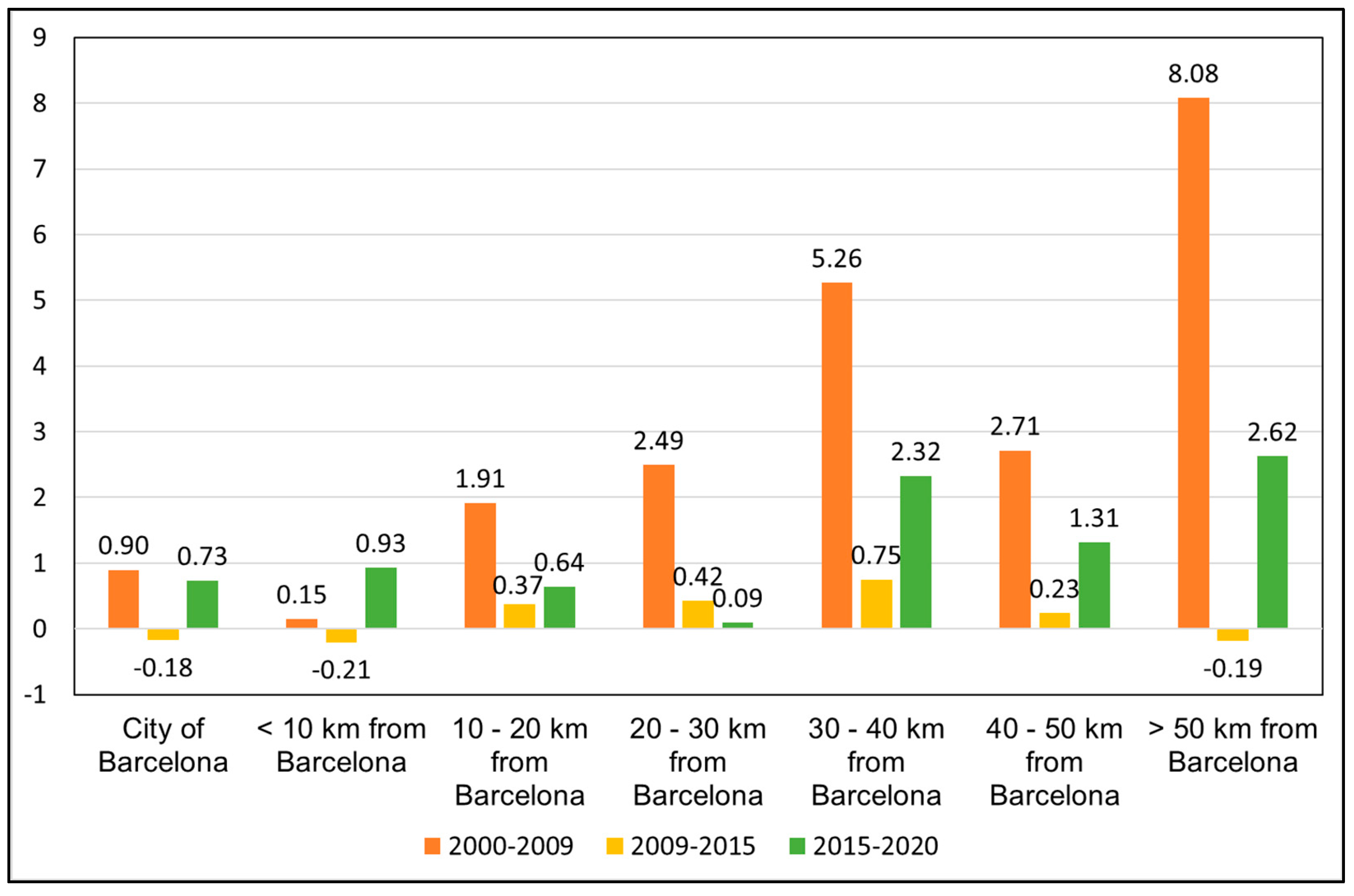
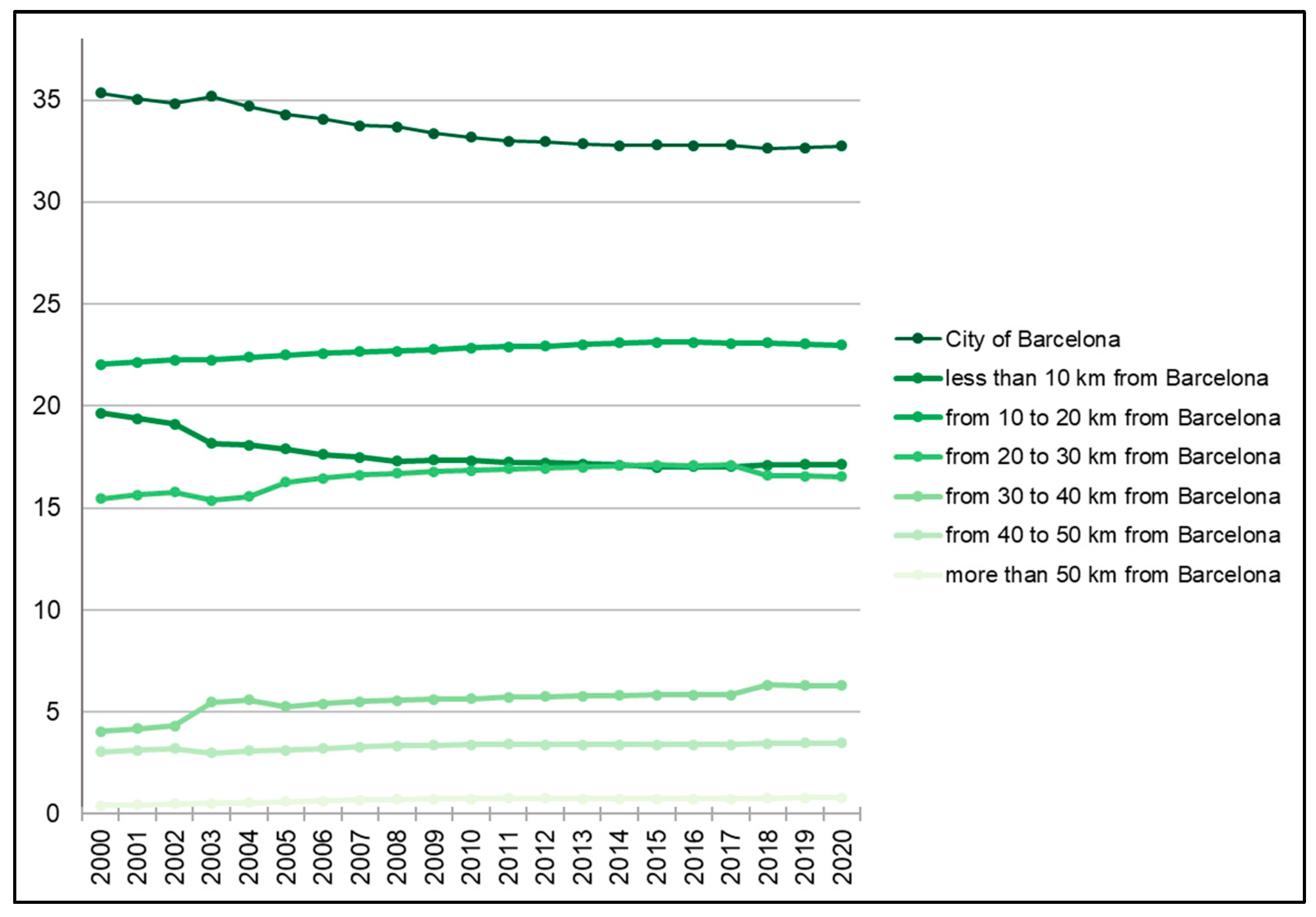
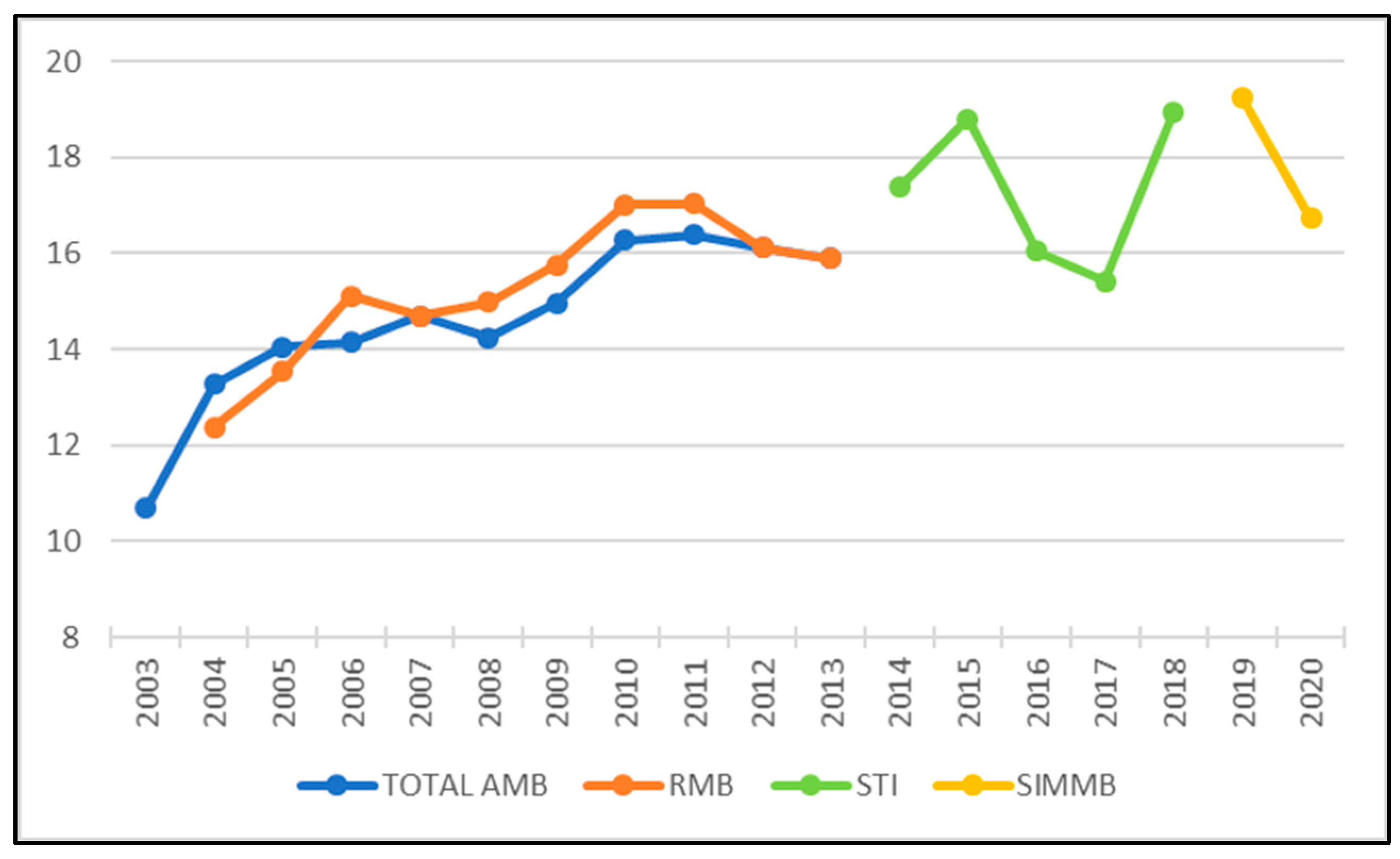
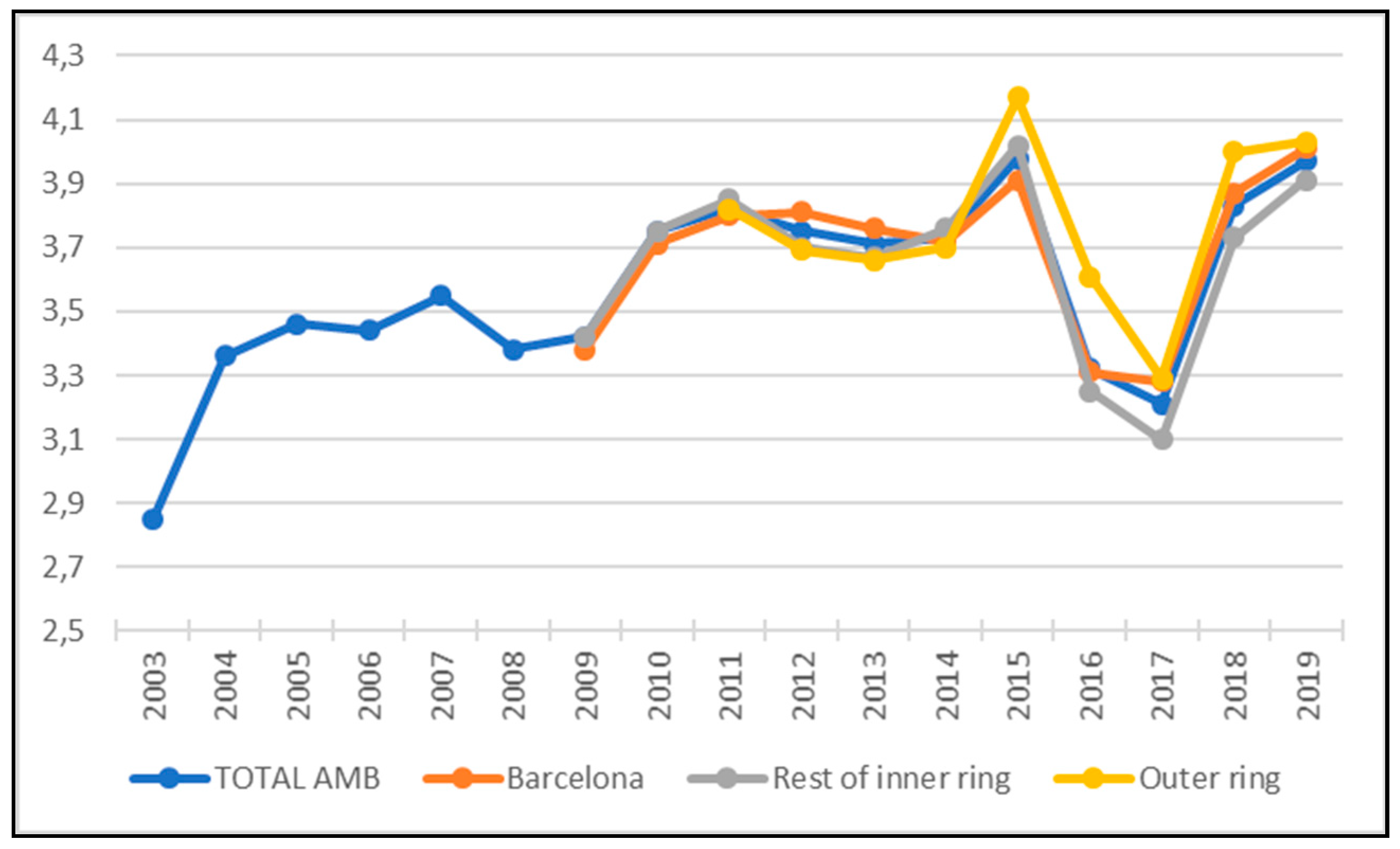

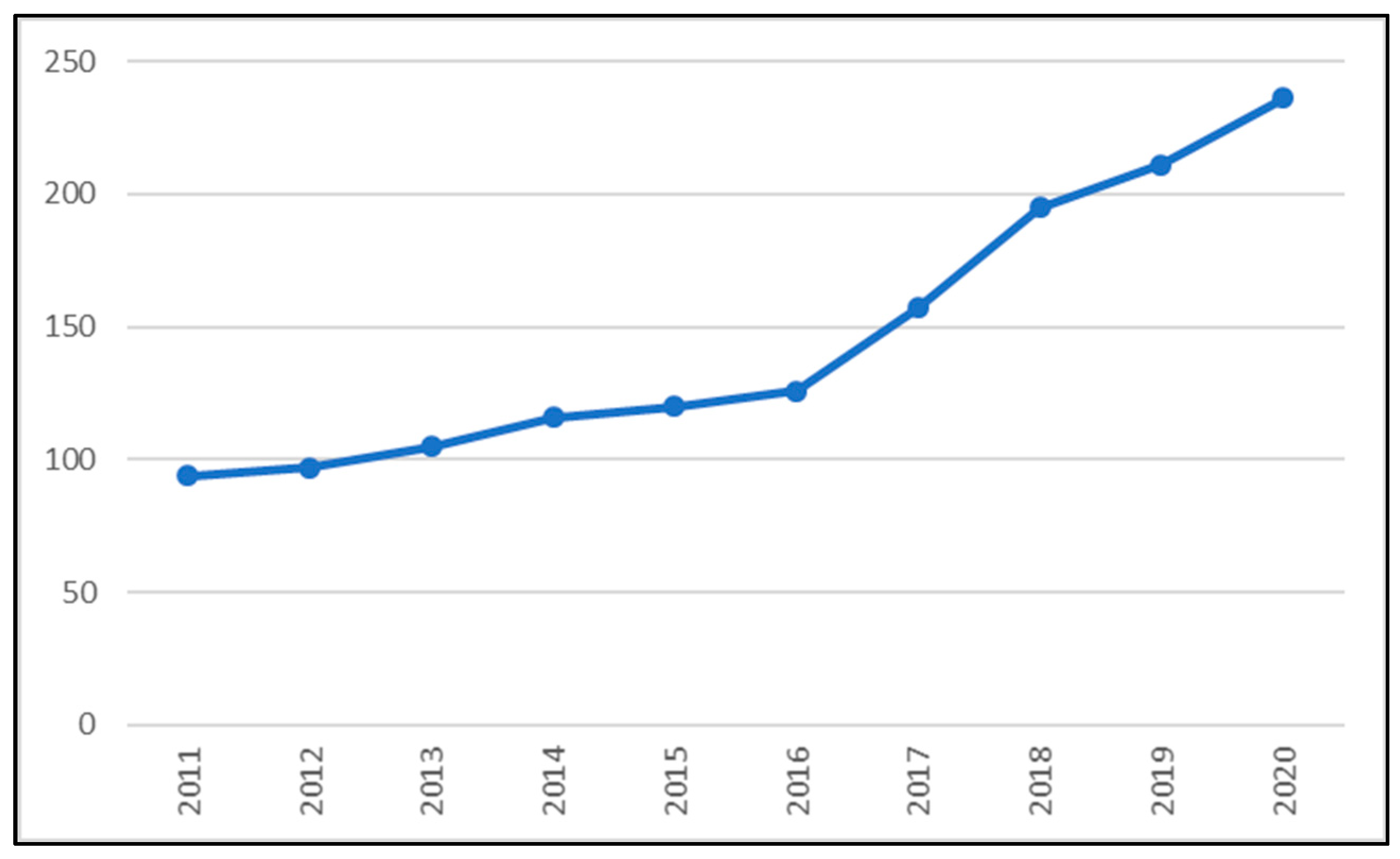


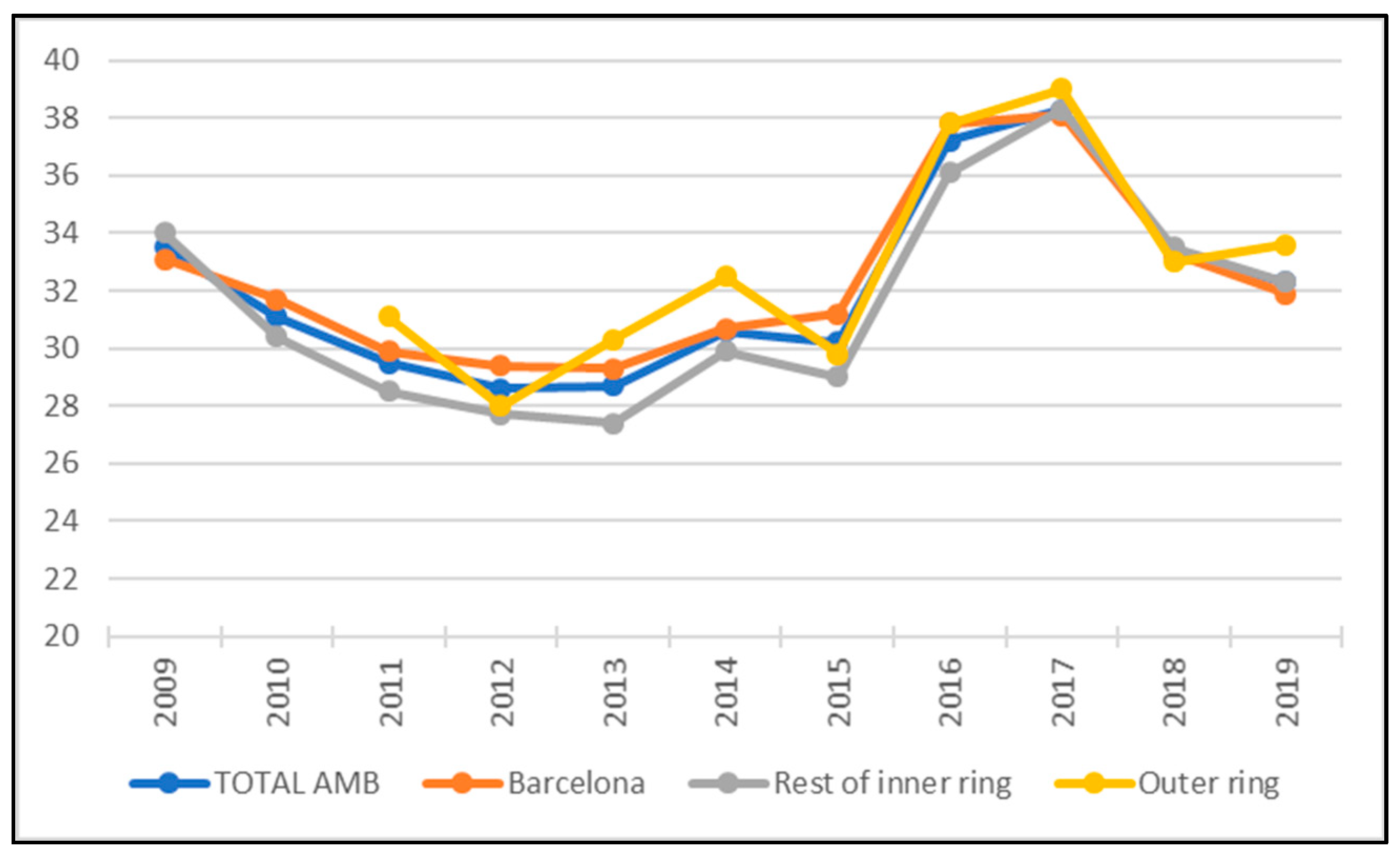
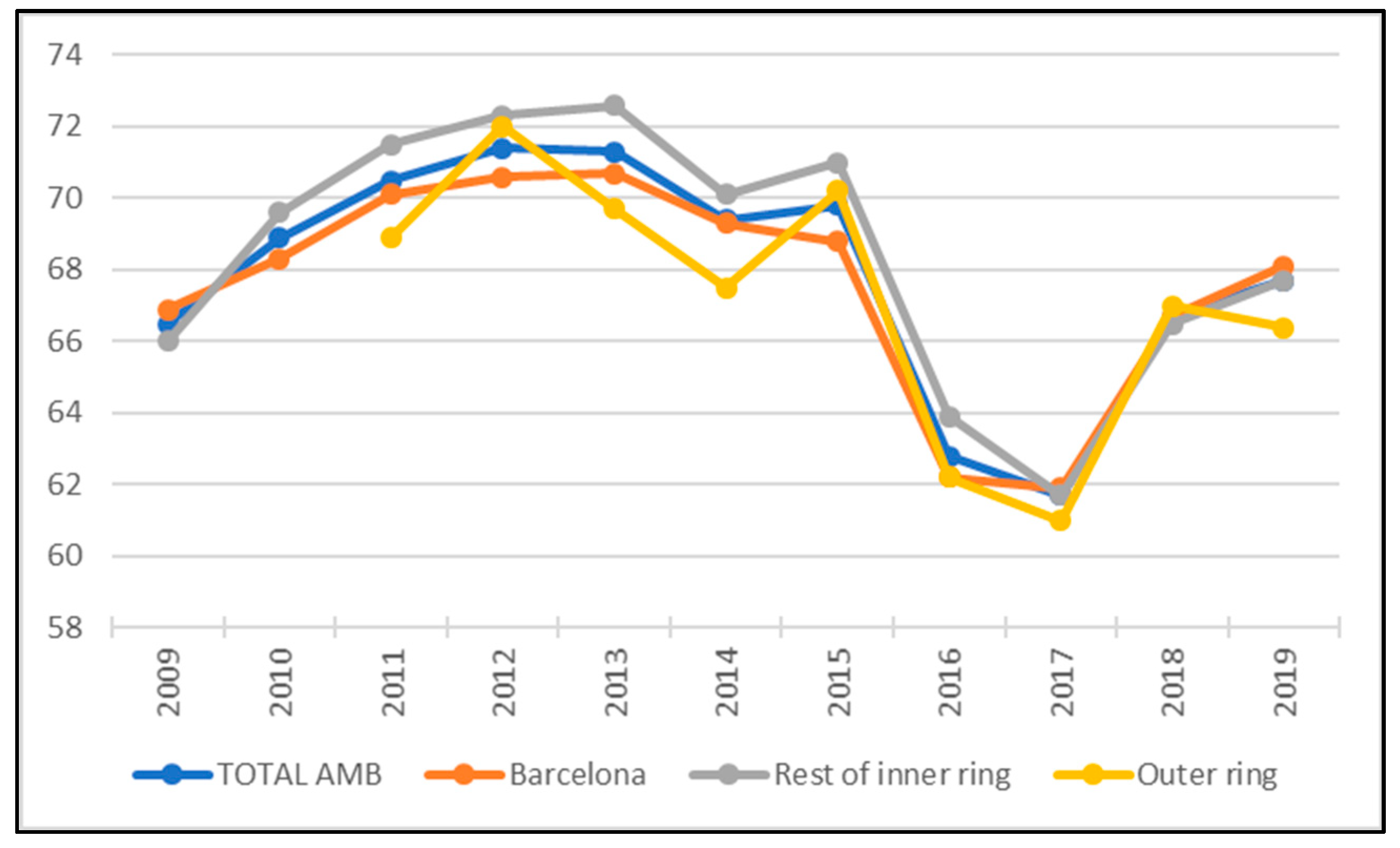

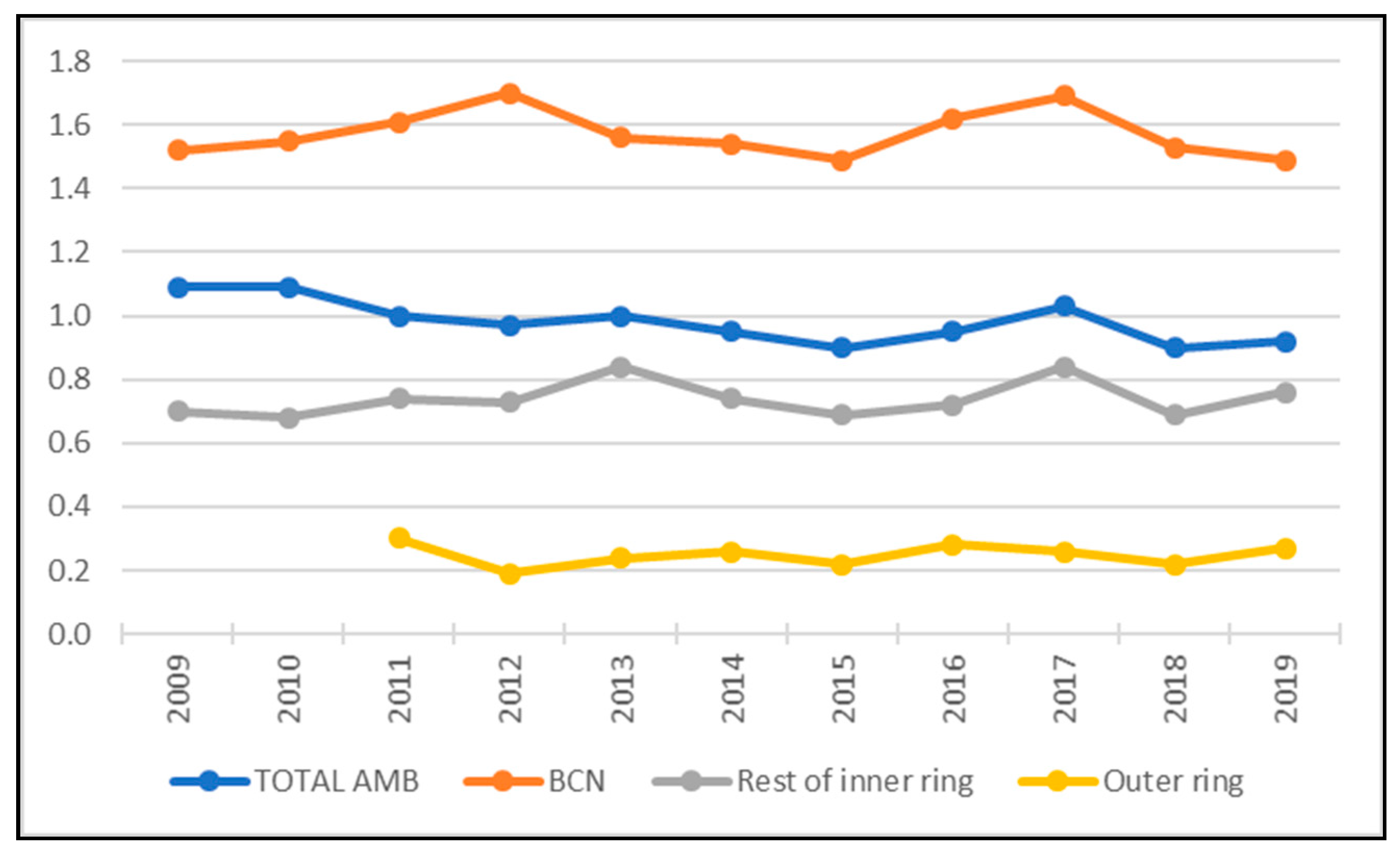


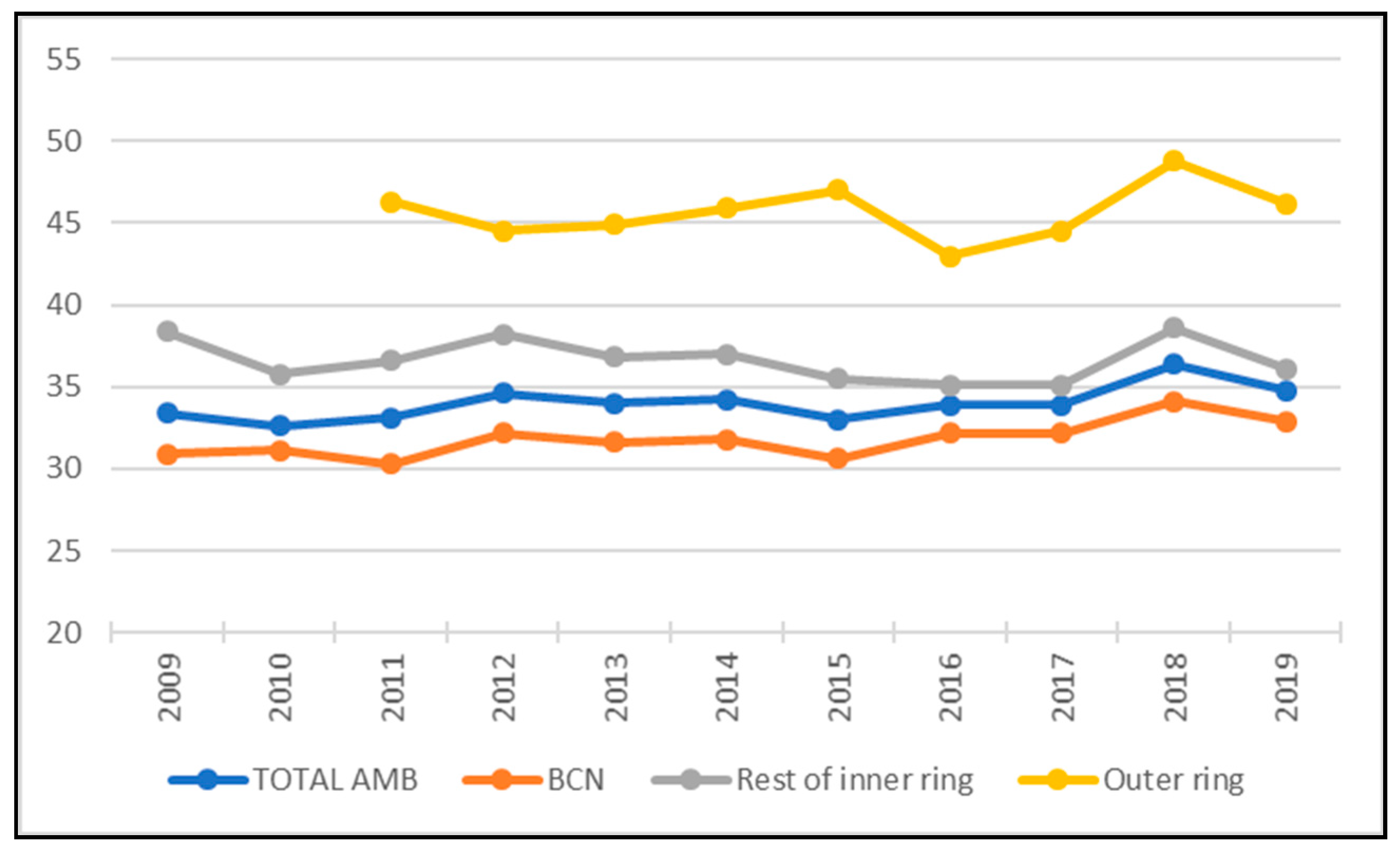
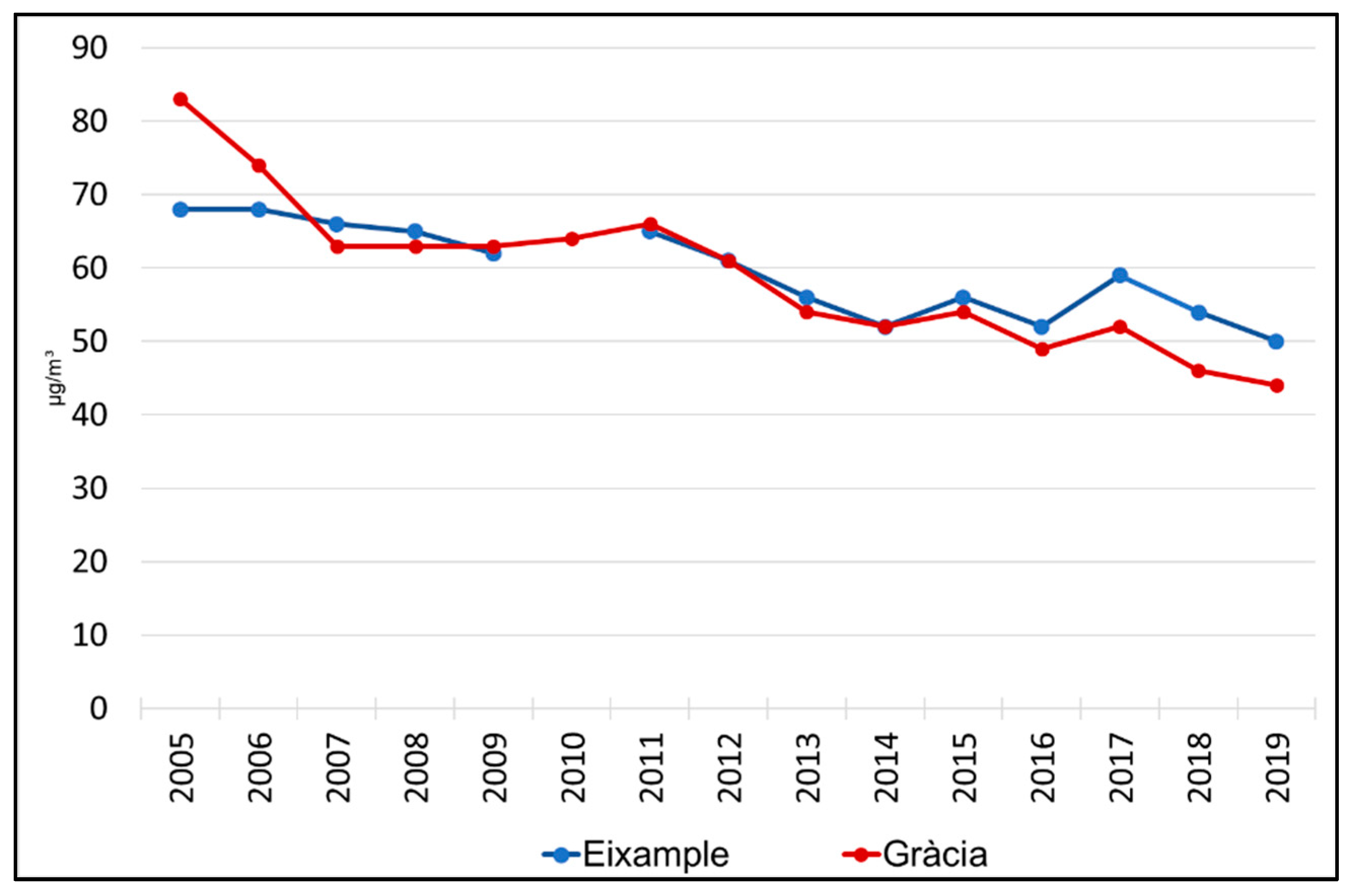
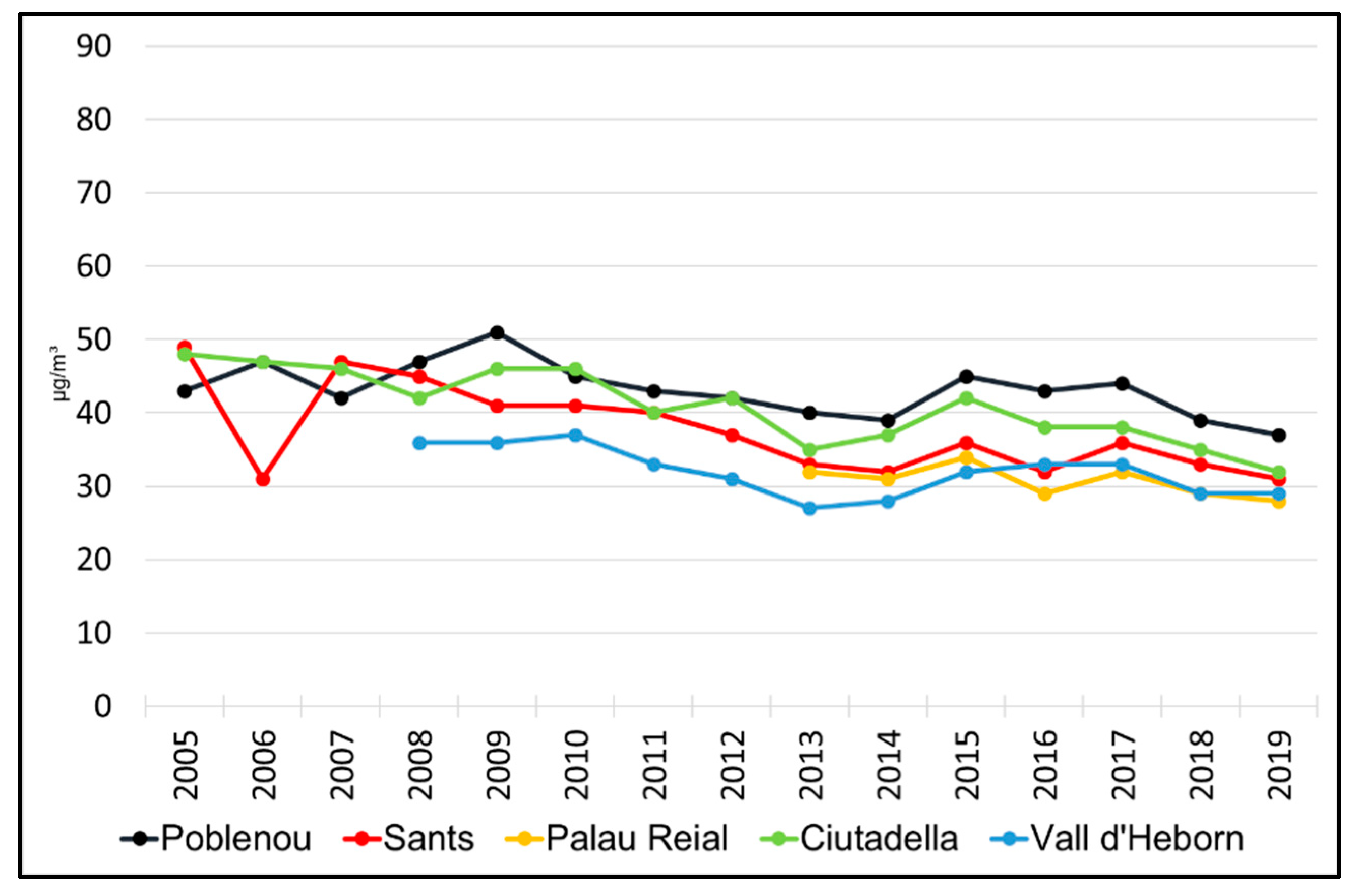
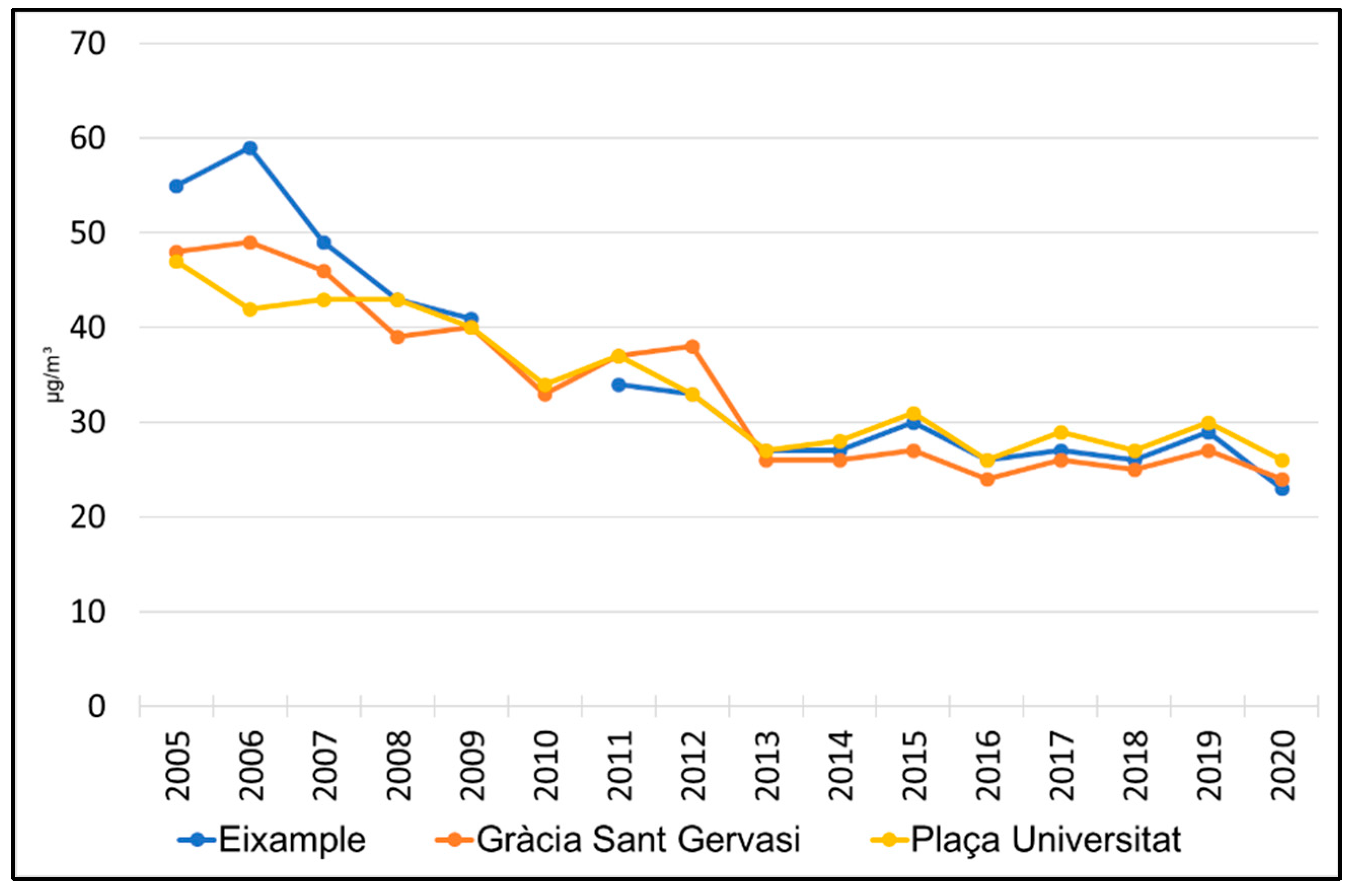
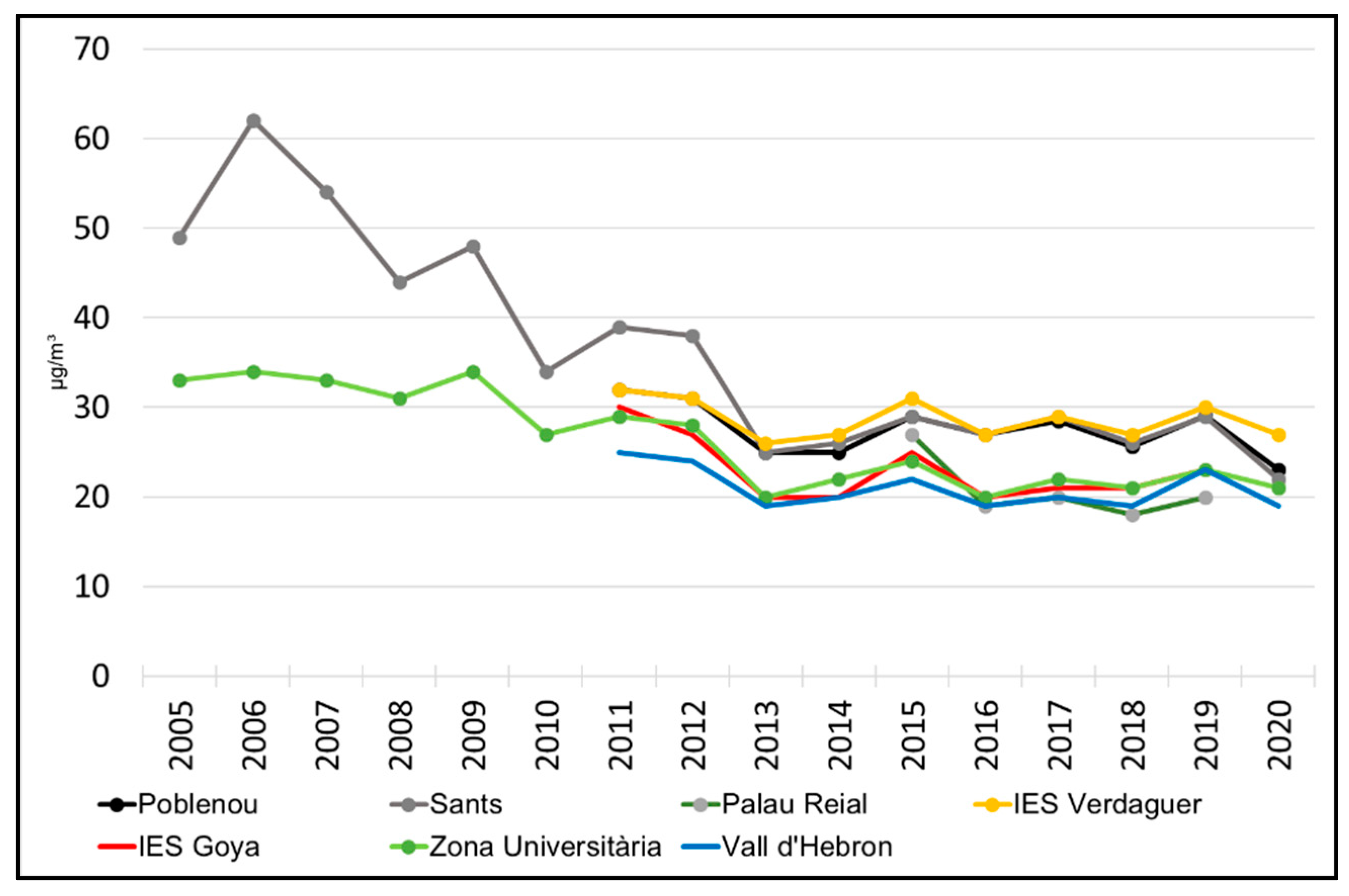
| Inhabitants 2013 | % | Inhabitants 2019 | % | Growth Rate (%) 2013–2019 | |
|---|---|---|---|---|---|
| Total AMB | 3,228,569 | 100.0 | 3,291,654 | 100.0 | 0.32 |
| Barcelona | 1,611,822 | 49.9 | 1,636,762 | 49.7 | 0.26 |
| Rest of inner ring | 1,231,273 | 38.1 | 1,259,445 | 38.3 | 0.38 |
| Total inner ring | 2,843,095 | 88.1 | 2,896,207 | 88.0 | 0.31 |
| Outer ring | 385,474 | 11.9 | 395,447 | 12.0 | 0.43 |
| Distance | Nº Municipalities | 2000 | 2009 | 2015 | 2020 | % Growth Rate 2000–2020 |
|---|---|---|---|---|---|---|
| Barcelona | 1 | 1,496,266 | 1,621,537 | 1,604,555 | 1,664,182 | 0.53 |
| <10 km | 9 | 831,584 | 842,673 | 832,236 | 871,579 | 0.24 |
| from 10 to 20 km | 39 | 932,776 | 1,106,177 | 1,131,213 | 1,167,826 | 1.13 |
| from 20 to 30 km | 36 | 653,814 | 815,882 | 836,766 | 840,692 | 1.26 |
| from 30 to 40 km | 30 | 171,743 | 272,528 | 284,998 | 319,702 | 3.16 |
| from 40 to 50 km | 18 | 128,662 | 163,698 | 166,018 | 177,219 | 1.61 |
| >50 km | 2 | 18,162 | 36,544 | 36,139 | 41,134 | 4.17 |
| Total FUA | 135 | 4,233,007 | 4,859,039 | 4,891,925 | 5,082,334 | 0.92 |
| 2019 | % | 2013 | % | ||
|---|---|---|---|---|---|
| On foot | 5,313,690 | 47.9 | On foot | 5,063,051 | 49.7 |
| Bicycle | 211,993 | 1.9 | Bicycle | 163,492 | 1.6 |
| Scooter | 39,647 | 0.4 | Scooter | 0 | 0.0 |
| Total active mobility | 5,580,219 | 50.3 | Total active mobility | 5,226,543 | 51.3 |
| Bus | 945,632 | 8.5 | Bus | 867,048 | 8.5 |
| Metro | 1,055,903 | 9.5 | Metro | 1,009,074 | 9.9 |
| Other trains | 544,305 | 4.9 | Other trains | 509,771 | 5.0 |
| Rest of public transport | 102,146 | 0.9 | Rest of public transport | 90,811 | 0.9 |
| Total public transport | 2,647,986 | 23.8 | Total public transport | 2,476,704 | 24.3 |
| Car driver | 1,843,671 | 16.6 | Car driver | 1,607,606 | 15.8 |
| Car passenger | 369,876 | 3.3 | Car passenger | 357,060 | 3.5 |
| Motorbike | 552,275 | 5.0 | Motorbike | 493,072 | 4.8 |
| Rest private vehicle | 97,696 | 0.9 | Rest private vehicle | 28,722 | 0.3 |
| Total private vehicle | 2,863,518 | 25.8 | Total private vehicle | 2,486,460 | 24.4 |
| Total daily movements | 11,091,723 | 100.0 | Total daily movements | 10,189,707 | 100.0 |
| 2019 | % | 2013 | % | ||
|---|---|---|---|---|---|
| Total active mobility | Total active mobility | ||||
| Barcelona | 3,049,136 | 53.7 | Barcelona | 2,797,798 | 53.0 |
| Rest of inner ring | 1,983,278 | 48.2 | Rest of inner ring | 1,951,685 | 51.4 |
| Outer ring | 547,805 | 42.3 | Outer ring | 477,060 | 43.1 |
| Total public transport | Total public transport | ||||
| Barcelona | 1,574,131 | 27.7 | Barcelona | 1,512,227 | 28.6 |
| Rest of inner ring | 916,551 | 22.3 | Rest of inner ring | 842,197 | 22.2 |
| Outer ring | 157,304 | 12.1 | Outer ring | 122,280 | 11.0 |
| Total private vehicle | Total private vehicle | ||||
| Barcelona | 1,058,947 | 18.6 | Barcelona | 971,471 | 18.4 |
| Rest of inner ring | 1,213,613 | 29.5 | Rest of inner ring | 1,006,813 | 26.5 |
| Outer ring | 590,958 | 45.6 | Outer ring | 508,177 | 45.9 |
| 2013 | Commuting | Other reasons | Total daily movements |
| Private transport | 37.2 | 19.3 | 24.4 |
| Public transport | 40.2 | 17.9 | 24.3 |
| Active mobility | 22.7 | 62.8 | 51.3 |
| Total | 100.0 | 100.0 | 100.0 |
| 2019 | Commuting | Other reasons | Total daily movements |
| Private transport | 37.0 | 20.5 | 25.8 |
| Public transport | 38.5 | 16.9 | 23.9 |
| Active mobility | 24.6 | 62.6 | 50.3 |
| Total | 100.0 | 100.0 | 100.0 |
| Badalona | Barcelona | L’Hospitalet de Llobregat | Montcada i Reixac | S. Adrià del Besòs | S. Andreu de la Barca | S. Cugat del Vallès | S. Vicenç dels Horts | Santa Coloma de Gramenet | |
|---|---|---|---|---|---|---|---|---|---|
| 2004 | 51 | 46 | 52 | 47 | 66 | 21 | 56 | 41 | 51 |
| 2005 | 47 | 28 | 56 | 54 | 52 | 14 | 66 | 17 | 55 |
| 2006 | 53 | 26 | 49 | 58 | 55 | 40 | 59 | 13 | 54 |
| 2007 | 54 | 29 | 54 | 55 | 53 | 57 | 58 | 15 | 51 |
| 2008 | 54 | 43 | 55 | 56 | 46 | 57 | 57 | 35 | 56 |
| 2009 | 54 | 51 | 52 | 53 | 38 | 54 | 53 | 44 | 51 |
| 2010 | 48 | 52 | 42 | 30 | 38 | 51 | 50 | 43 | 50 |
| 2011 | 57 | 57 | 56 | 35 | 49 | 64 | 60 | 44 | 66 |
| 2012 | 57 | 58 | 57 | 42 | 44 | 65 | 65 | 44 | 66 |
| 2013 | 49 | 55 | 57 | 46 | 48 | 57 | 56 | 48 | 61 |
| 2014 | 52 | 56 | 58 | 43 | 45 | 59 | 58 | 47 | 60 |
| 2015 | 50 | 51 | 49 | 38 | 44 | 58 | 56 | 42 | 61 |
| 2016 | 51 | 52 | 55 | 50 | 48 | 59 | 60 | 49 | 62 |
| 2017 | 51 | 52 | 55 | 52 | 50 | 59 | 57 | 50 | 62 |
| 2018 | 55 | 56 | 54 | 52 | 50 | 62 | 60 | 57 | 65 |
| 2019 | 55 | 53 | 58 | 53 | 49 | 63 | 60 | 53 | 64 |
Publisher’s Note: MDPI stays neutral with regard to jurisdictional claims in published maps and institutional affiliations. |
© 2022 by the authors. Licensee MDPI, Basel, Switzerland. This article is an open access article distributed under the terms and conditions of the Creative Commons Attribution (CC BY) license (https://creativecommons.org/licenses/by/4.0/).
Share and Cite
Gil-Alonso, F.; López-Villanueva, C.; Thiers-Quintana, J. Transition towards a Sustainable Mobility in a Suburbanising Urban Area: The Case of Barcelona. Sustainability 2022, 14, 2560. https://doi.org/10.3390/su14052560
Gil-Alonso F, López-Villanueva C, Thiers-Quintana J. Transition towards a Sustainable Mobility in a Suburbanising Urban Area: The Case of Barcelona. Sustainability. 2022; 14(5):2560. https://doi.org/10.3390/su14052560
Chicago/Turabian StyleGil-Alonso, Fernando, Cristina López-Villanueva, and Jenniffer Thiers-Quintana. 2022. "Transition towards a Sustainable Mobility in a Suburbanising Urban Area: The Case of Barcelona" Sustainability 14, no. 5: 2560. https://doi.org/10.3390/su14052560
APA StyleGil-Alonso, F., López-Villanueva, C., & Thiers-Quintana, J. (2022). Transition towards a Sustainable Mobility in a Suburbanising Urban Area: The Case of Barcelona. Sustainability, 14(5), 2560. https://doi.org/10.3390/su14052560






